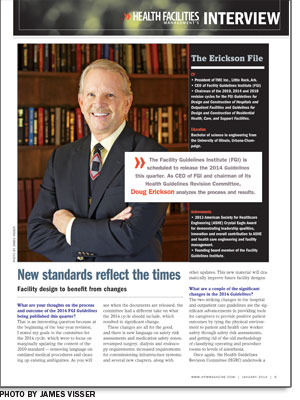
The Facility Guidelines Institute (FGI) is scheduled to release the 2014 Guidelines this quarter. As CEO of FGI and chairman of its Health Guidelines Revision Committee, Doug Erickson analyzes the process and results.
What are your thoughts on the process and outcome of the 2014 FGI Guidelines being published this quarter?
That is an interesting question because at the beginning of the four-year revision, I stated my goals to the committee for the 2014 cycle, which were to focus on marginally updating the content of the 2010 standard — removing language on outdated medical procedures and cleaning up existing ambiguities. As you will see when the documents are released, the committee had a different take on what the 2014 cycle should include, which resulted in significant change.
These changes are all for the good, and there is new language on safety risk assessments and medication safety zones; revamped surgery, dialysis and endoscopy requirements; increased requirements for commissioning infrastructure systems; and several new chapters, along with other updates. This new material will dramatically improve future facility designs.
What are a couple of the significant changes in the 2014 Guidelines?
The two striking changes in the hospital and outpatient care Guidelines are the significant advancements in providing tools for caregivers to provide positive patient outcomes by tying the physical environment to patient and health care worker safety through safety risk assessments, and getting rid of the old methodology of classifying operating and procedure rooms to levels of anesthesia.
Once again, the Health Guidelines Revision Committee (HGRC) undertook a difficult task of throwing decades-old language out and replacing it with requirements that reflect the direction health care has headed over the past decade.
What are the most significant challenges in keeping health care facility standards current and relevant?
Believe it or not, it is not the standards-writing process that is holding progress back, it is the lack of adoption of the most recent codes and standards by federal and state authorities that is the overwhelming problem.
As most people know, the Centers for Medicare & Medicaid Services (CMS) is referencing the 2000 edition of the National Fire Protection Association (NFPA) Life Safety Code, which is based on 15-year-old thinking and technology.
In my opinion, this one old reference is costing health care between $5 billion and $15 billion a year. In an era in which reimbursement is diminishing and health care costs are skyrocketing, this is totally unacceptable behavior.
Other examples of old references are the continued enforcement of the 1996–97, 2001 and 2006 editions of the FGI Guidelines by state departments of health. By enforcing old standards, in many cases, we are building brand new "old" hospitals.
How are standards-writing organizations keeping up with the changes in health care?
A good example of breakthrough thinking is the 2012 edition of NFPA 99. I was fortunate enough to be the chair of NFPA 99 when the Technical Correlating Committee decided to embrace the need to completely rewrite the 25-year-old document.
This takes a lot of guts, commitment and fortitude by a set of volunteer committees and, after seven years in planning, development and writing, the code has a completely different feel and applicability.
While it is not perfect, once CMS permits its use, it will allow health care organizations to take advantage of significant changes that will increase the quality of patient care while reducing the cost of constructing and maintaining health care facilities.
Of the major changes, a few stand out: going to a risk-based decision process for code compliance, deleting the need for smoke management systems in anesthetizing areas, limiting selective coordination of essential power supply systems, and deleting the 35 percent relative humidity requirement in operating rooms.
Another good example was the decision by FGI to separate the residential requirements from those of hospitals and outpatient care facilities. For decades, the Guidelines included both hospital and long-term care nursing facilities in the same document and, quite frankly, the nursing facility portion received inadequate updates and review.
A new document was approved and developed by bringing together expertise from the long-term care community along with those organizations that represent this important aspect of well-being and care. The new Guidelines for Design and Construction of Residential Health, Care, and Support Facilities will transform the ability for state and federal organizations to adopt and enforce state-of-the-art standards for long-term care.
Why is the creation of the FGI Guidelines for Design and Construction of Residential Health, Care, and Support Facilities important?
Developed in response to the widespread adoption of person-centered care and deinstitutionalization in the residential care industry, the new Guidelines are based on the requirements for residential care facilities in the 2010 edition of the FGI Guidelines for Design and Construction of Health Care Facilities and public proposals submitted on that text in the fall of 2011.
The new FGI Guidelines, created with an interdisciplinary volunteer team, is a milestone document created to support the evolution of long-term care environments, while providing consistent guidance for providers, design professionals and authorities having jurisdiction. The ultimate goal is to provide the framework for environments that support positive resident outcomes.
What other national standards have made significant changes?
One of the greatest achievements in the 2010 Guidelines was the marriage of ASHRAE 170, Standard for Health Care Ventilation, and the Guidelines. Once again, rather than resist the need for change, ASHRAE and FGI worked closely to coordinate the two documents, and the Guidelines incorporates ASHRAE 170 as its ventilation standards.
The ASHRAE 170 Standing Committee has been doing a monumental job of keeping up with change and modifying its document through formal addenda. Recent changes in lowering the level requirements in relative humidity, reduction in total air changes in patient rooms, ducted versus plenum returns and a pending air change per hour reduction for exam rooms is just a start of what this committee is doing to keep up with the times.
The fact that formal changes can be made on an as-needed basis, called continuous maintenance, is a testament to the ASHRAE process. The new 2013 ASHRAE 170, which will include approved addenda through November 2013, will be incorporated into the 2014 Guidelines for Design and Construction of Hospitals and Outpatient Facilities and the Guidelines for Design and Construction of Residential Health, Care, and Support Facilities.
There is a national effort under way to try to unify the codes and standards. How is that progressing?
Yes, much has been written on this topic and ASHE is working closely with the International Code Council and other organizations to make this happen. In the mid-2000s, we began looking at the opportunity to consolidate the building and life safety standards. As one of our more prominent members said, "Even if the outcome is a more restrictive code, at least we will only have one to follow."
While I am no longer active in this effort, I am still a strong believer that we cannot have multiple and diverse codes being applied to health care organization projects. Just the other day, it cost a client more than $450,000 because of a code conflict and the state agency's stance of layering the International Building Code and Life Safety Code requirements (taking the most stringent of each).
The baffling piece of this story is that if the city building code official had surveyed for code compliance, the project would have been in compliance, and if CMS or the Joint Commission had surveyed them, it also would have been in compliance.
But because the state department of health claims that it is mandated to follow both codes, well, cha-ching! No additional safety was achieved for a price tag of close to a half million dollars. It's madness in my opinion.
| Sidebar - The Erickson File |
CV:
EducationBachelor of science in engineering from the University of Illinois, Urbana-Champaign. Achievements
|





